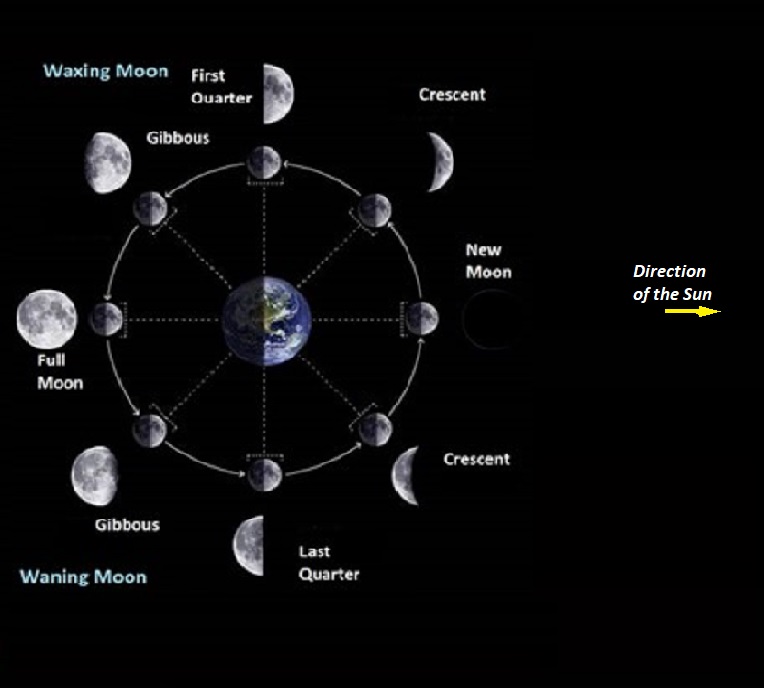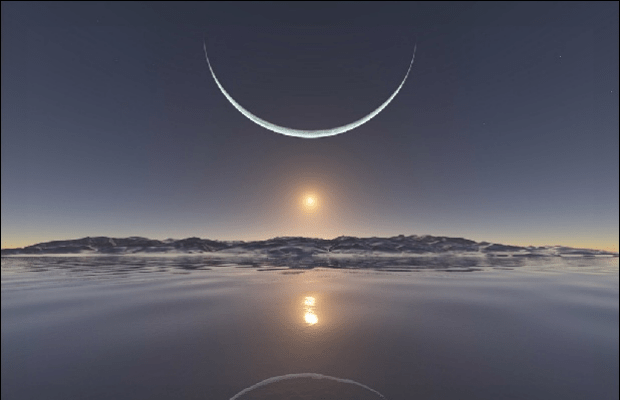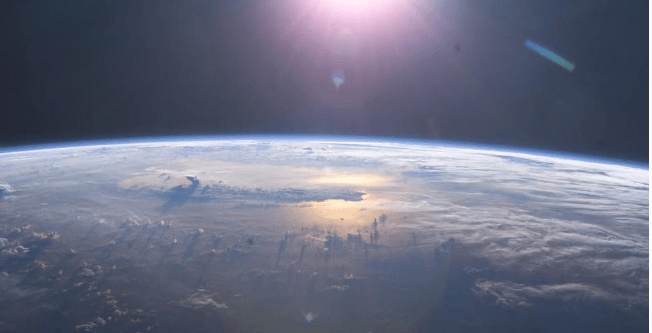A friend of mine, the keen amateur astronomer Colin Henshaw, brought the following photograph to my attention. It appears to show the Moon rising over Mossel Bay in South Africa. Although it was passed off as a genuine image, in fact it must be a fake.

If you study the Moon, it is how it appears to an observer in the Northern Hemisphere. If the photo was genuinely taken from Mossel Bay, then the Moon should be the way it appears in the Southern Hemisphere (upside down to viewers in the Northern Hemisphere). Furthermore, the Moon is only half a degree (one Moon’s width) above the horizon. If the image had been genuine the Moon would have a reddish colour because, when near the horizon, the Moon’s light travels a longer distance through the atmosphere, compared to when it is higher in the sky. As it travels a longer path, more of the shorter, bluer wavelengths of light are scattered away, leaving more of the longer, redder wavelengths. The Sun appears redder near the horizon for the same reason.
The Moon appears as a perfect circle whereas when it close to the horizon it appears flattened due to differential atmospheric refraction. To find out more about this effect click here
Finally, if you look carefully at the Moon’s reflection, it is not directly under the Moon, as it should be in a genuine image but is a little off to the left.
Although fake, the fakery was fairly subtle and the photo could easily mislead a non-astronomer as being genuine. I’ll now talk about a number of fake images which have been circulating in which the fakery is more blatant.
Full moon and Sun together

Source https://www.pinterest.co.uk/pin/484559241154829085/
This has the caption “Moon and sun in the same line between two trees”.
Clearly the author knows nothing about astronomy! When there is a full moon, the Sun and the Moon are 180 degrees apart ( i.e. on opposite sides of the sky). When the Moon appears close to the Sun it can only appear as a very thin crescent.

Starting with a new moon, when the Moon appears close to the Sun in the sky and is not visible at all, the sunlit part of the Moon gets successively larger or waxes through to the crescent phase then to a half moon (also known as the first quarter) and finally to a full moon, at which point the whole of the sunlit side of the Moon is fully visible. After the full moon, the sunlit part then gets smaller or wanes back to a half moon (also known as the last quarter), then to a crescent and then finally back to a new moon again. On average this cycle lasts 29.531 days.
Hideaway – image of a sunset at the North Pole

This photo has been circulating widely on the internet since it first appeared back in 2006. It claims to show a picture of a sunset at the North Pole. The caption below has been attached to the image.
A scene you will probably never get to see in person. This is the sunset at the North Pole with the moon at its closest point, so take a moment and enjoy God at work at the North Pole. An amazing photo and not one easily duplicated.
In fact the image was computer generated by a German artist Inga Nielson The picture cannot be real for a number of reasons, the most obvious one being that the Sun and Moon are approximately the same apparent size when viewed from Earth!
Fake photo taken from the ISS

This photo was widely circulating on the Internet five years ago and claimed to be a photo of the Milky Way and an almost full moon taken from the International Space Station. In fact, the image is clearly faked for a number of reasons.
- The Moon is too big in comparison to the Milky Way.
- The relative brightness of the Milky Way and the Moon are completely wrong. The Milky Way is relatively faint and on Earth it is only possible to see it with the naked eye against a dark sky. The Moon is very bright, particularly at full moon. To show the Milky Way at the level of detail would require a long exposure, in which case the image would be saturated by the brightness of the Moon.
- The Milky Way is not curved
- The area below the Moon looks like a reflection of the Sun in an ocean, yet the Sun does not appear in the image. Looking at the position of the reflection, the Sun should be a little above where the Moon is positioned on the image.
In fact, the image was almost certainly produced by manipulating the following NASA image

Image credit NASA
The Aurora – not a fake image but can be misleading

Image credit NASA
This image is genuine, but it is a long exposure photograph. Many people who travel to higher latitudes, on aurora viewing trips, expect to see brilliant glowing lights like this with the naked eye and end up being disappointed. Aurora are faint flickering phenomena caused by electrically charged particles striking the Earth’s upper atmosphere. To see them you need to go to a dark location at a time when aurora are forecast. There are many space weather websites such as https://www.swpc.noaa.gov/products/aurora-30-minute-forecast which are useful. Even in such a location they will be, in general, fairly faint to the naked eye and not be as brilliant lights like those shown in the photo.

Faser Cain did a video with fake space pictures on YouTube called “I Used AI to Imagine Space Stuff. Here’s What Happened”, The second half of the video has the more interesting space images.
LikeLike
Thanks for letting me know. I’ll check it out
LikeLike
Beautiful photos and excellent article 👍 thanks for sharing ☺️☺️😊
LikeLike
Thank you
LikeLike
Further to Dee’s comment:
I’d suggest that “fake” implies a deliberate attempt to deceive for a dubious purpose, as opposed to the more neutral “false”. The use of falsity is sometimes essential to convey information in a digestible way isn’t it. For instance a diagram of the solar system usually needs to employ false scaling if it’s to fit onto a page & still be legible – though admittedly it should say so. We’d agree that false coloring of images is inevitable in modern astronomy (radio; infra-red; X-ray etc) to provide a meaningful picture, especially if it includes a spread of wavelengths. I think that that would be generally accepted & not branded as fake (except by someone unusually paranoid!).
One of the early photos taken by the Apollo astronauts showed an view from the spacecraft of the Moon’s sunlit surface from a very low altitude. Many people condemned it as a fake because the sky was uniformly black & showed no stars. Of course the brilliance reflected from the ground almost saturated the camera & to show any ground features they had to use a setting that prevented stars being visible.
In the early days of television, the BBC made a rather whimsical introductory image to the news. It showed the vertical transmitting mast, the top of which had semi-transparent circular ripples radiating outwards (they’d probably superimposed an image of ripples in some water with an object dropped in from above). Anyway, people within sight of the transmitter were aggrieved that there was in fact nothing to be seen, and raised numerous complaints!
LikeLike
Lots of pretty pictures out there. But, they aren’t real images. I’ve come across some over the years. Even some basic knowledge can help a novice know it is suspicious. Some of your examples made me laugh. Thanks.
LikeLike
Thanks Jim,
you’re very welcome
LikeLike
The first two fakes could definitely fool even the smartest, but the last two Moon images just look hilarious! I looks like something my mother would post on Facebook with a link to a conspiracy theory article!
LikeLike
😉
LikeLike
Nice
LikeLike
Thank you
LikeLike
Very interesting, thank you for your explanations
LikeLike
You’re very welcome
LikeLike
👍
LikeLike
Great explanations!! I follow a couple of astrophotography groups and amateur photos being taken are amazing!! But outlandish supermoon pictures every apogee counter those!! I thought the article was going to be about false colors added to JST shots, may in a future post. Love your articles!! Thanks!!
LikeLike
Thank you !
LikeLike
Always amazes me how gullible people are when its well k own how easy it is to fake images. In some of the foraging groups i follow, edible fungi the size of small trees not uncommon!
LikeLike
Very true! The world is full of gullible people
LikeLike